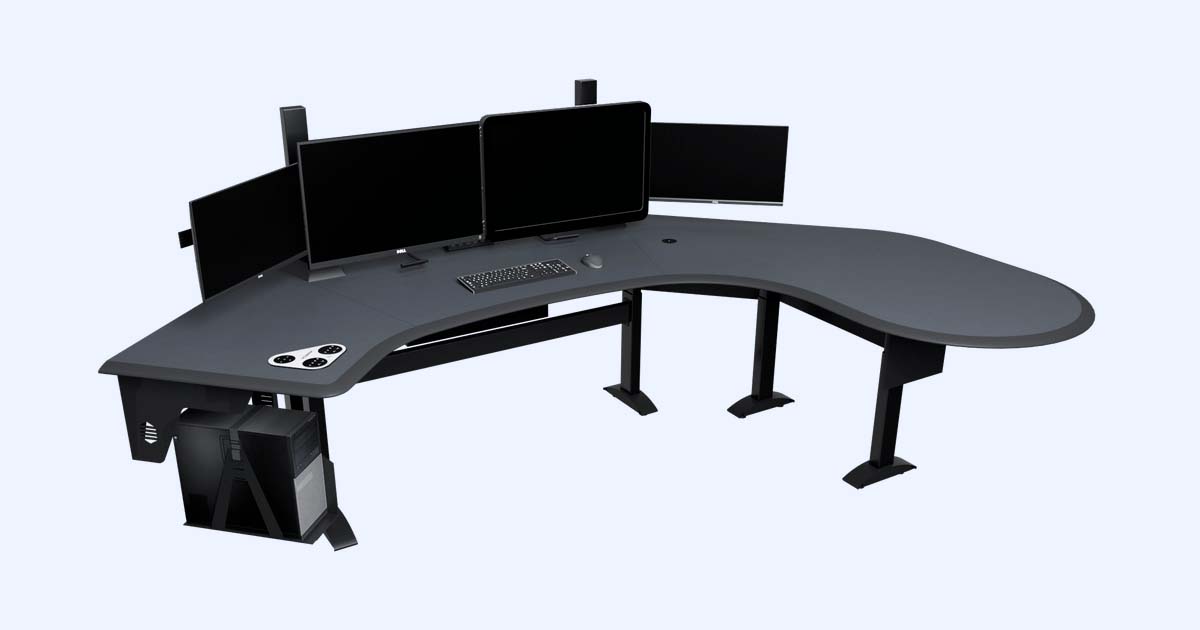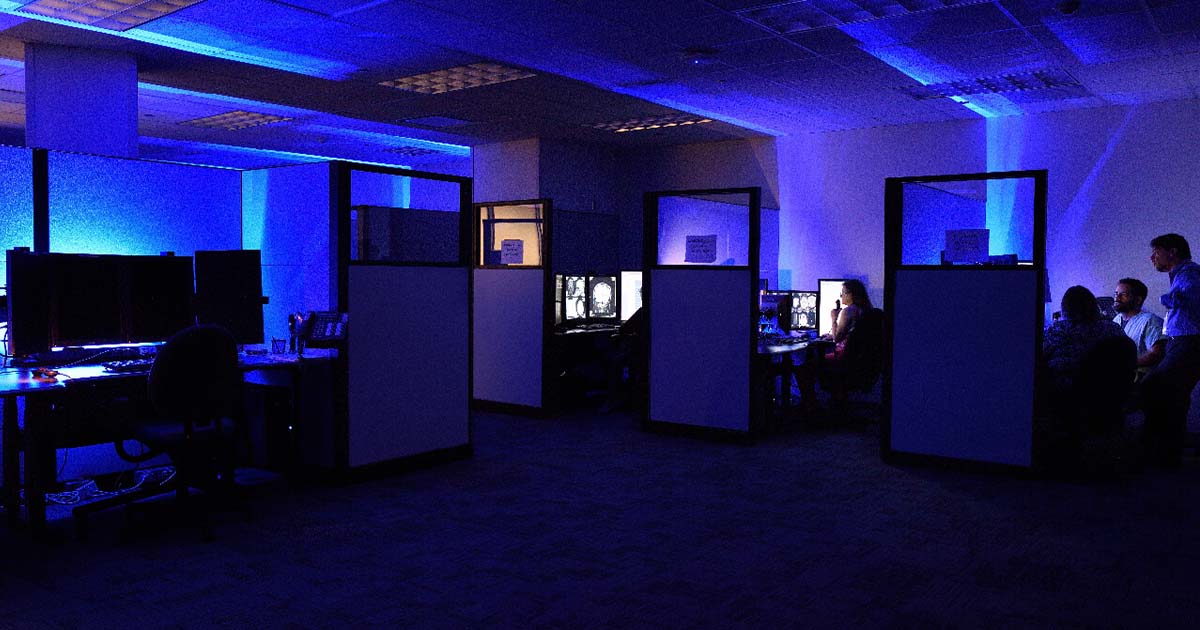
We collect basic website visitor information on this website and store it in cookies. We also utilize Google Analytics to track page view information to assist us in improving our website.

Radiologist burnout is a pressing problem that affects physicians at all stages of their career. Endless working hours, overwhelming administrative burdens, a feeling of being undervalued, and other factors contribute to the mental exhaustion and cognitive issues that characterize burnout.
Solving the problem takes more than just giving radiologists a break – it's about radically changing how radiologists work. And this is where ergonomic workstations step in to help.
In this article, we'll explore how ergonomic workstations like the ones we design at RedRick Technologies help tackle the deep-seated causes of radiologist burnout head-on. From cutting down physical discomfort and administrative overload to enhancing autonomy and improving work-life balance, ergonomics make a real difference.
At RedRick Technologies, we design and develop ergonomic workspaces for healthcare professionals that include workstations, monitor mounting solutions, accessories, and peripherals. We also provide ergonomic design services that help organizations implement ergonomic principles for improved space design and functionality.
Get in touch and let’s find ways to improve the ergonomic functionality of your workspace.
Burnout in the medical profession is not just a buzzword – it's a significant and growing issue. This insidious condition creeps up unexpectedly, often catching its victims off guard. The impact of burnout is profound, leading to challenges such as anxiety, cognitive impairment, and a diminished functional capacity.
Medscape's comprehensive Physician Burnout & Depression Report highlights the prevalence of this issue. The 2023 survey, which included 9,100 U.S. physicians across 29 specialties, revealed that burnout rates vary widely across medical fields, ranging from 26% to 60%. Radiologists, alarmingly, are among the most affected.
In the survey, 54% of radiologists reported experiencing burnout, a significant increase from 49% in 2022. This alarming statistic places radiology in the seventh position, tied with pulmonary medicine, for the highest rates of burnout among medical specialties.
These numbers underscore the necessity of understanding burnout in its entirety. Recognizing the symptoms and acknowledging the problem is the first step towards addressing this crisis.
Medscape's report identifies several key factors contributing to physician burnout across specialties:
Overwhelming Bureaucratic Tasks: A staggering 60% of physicians attribute their burnout to excessive administrative and paperwork demands.
Lack of Respect in the Workplace: Nearly 39% of physicians feel burnout due to inadequate respect from administrators, employers, colleagues, and staff.
Excessive Working Hours: Long working hours are a cause of burnout for 34% of physicians.
Limited Personal Autonomy: 32% of physicians experience burnout as a result of feeling a lack of control over their personal and professional lives.
Inadequate Compensation: For 28% of physicians, burnout stems from insufficient salaries.
Frustration with Electronic Medical Records: Another 28% are burdened by the complexities and inefficiencies associated with electronic medical record systems.
In the face of these challenges, institutions have a responsibility to explore solutions that address these factors, particularly in the field of radiology.
One solution lies in the design and installation of ergonomic workstations, tailored to the unique needs of radiologists. These workstations not only reduce the physical strain of long working hours but also contribute to a more efficient, respectful, and autonomy-supportive work environment.

One often-overlooked aspect of burnout is physical strain. While it may not be the primary cause of radiologist burnout, physical discomfort is a significant exacerbating factor. And in a field where long hours are spent analyzing images and reports, the physical toll on radiologists can be substantial.
Ergonomic workstations offer a solution to this problem.
First and foremost, they are tailored to reduce the physical strain that comes with the demands of radiology work. This involves creating a workspace that aligns with the natural posture of the body, reducing the risk of work-related injuries, and addressing the chronic discomforts that can arise from prolonged sitting or standing in suboptimal positions. By adjusting elements like the height and angle of monitors, the support provided by chairs, and the placement of key tools and equipment, ergonomic workstations make the physical aspect of radiologists' work less taxing.
By alleviating physical stress, ergonomic workstations can indirectly have a positive impact on the mental and emotional health of radiologists. A more comfortable physical work environment can lead to reduced frustration and anxiety, lower levels of fatigue, and an overall enhancement in mood and job satisfaction. This, in turn, can contribute to a decrease in the risk of burnout.
In the previous section, we discussed how ergonomic workstations can alleviate physical strain for radiologists. However, their benefits extend far beyond mere physical comfort.
One of the critical ways in which these workstations can combat burnout is by enhancing efficiency and reducing the time spent on bureaucratic tasks. This aspect is particularly relevant considering that a significant portion of physician burnout is attributed to the overwhelming administrative workload.
A well-designed ergonomic workstation does more than just adjust to the physical contours of the user. It serves as a hub of efficiency, streamlining work processes in several impactful ways. For radiologists, whose work often involves extensive interaction with electronic medical records (EMRs) and various diagnostic tools, an ergonomic setup can make a world of difference.
Another significant aspect is the facilitation of easy access to electronic medical records. In many traditional setups, navigating EMRs can be cumbersome and time-consuming, contributing to the administrative burden. Ergonomic workstations, however, can be equipped with multiple screens and user-friendly interfaces, allowing radiologists to access, view, and update medical records with greater ease and speed. This not only reduces the time spent on administrative tasks but also minimizes the mental fatigue associated with navigating complex EMR systems.
Personal autonomy in the workplace is a key factor in job satisfaction and mental wellbeing. The feeling of powerlessness or lack of control is a common contributor to professional burnout.
Ergonomic workstations address this issue head-on by offering a high degree of customization. This means that each workstation can be tailored to meet the specific needs and preferences of individual radiologists.
The customization options of an ergonomic workstation are wide-ranging. They range from adjustable desk heights and monitor stands to personalized lighting and sound systems.
Such flexibility allows radiologists to create a work environment that suits their individual physical requirements and work styles. For instance, one radiologist might prefer a standing desk to alleviate back pain, while another might opt for a multi-monitor setup to efficiently navigate through large volumes of imaging data.
This ability to personalize the workstation goes beyond mere physical comfort. It instills a sense of ownership and control in the radiologist. When professionals can adjust their environment to their liking, it fosters a deeper connection to their workspace. This connection can significantly counteract feelings of powerlessness and detachment, which are often cited in cases of burnout.
The efficiency and comfort provided by well-designed ergonomic workstations have a ripple effect on the overall work process of radiologists.
By significantly reducing physical strain and streamlining workflow, these workstations can lead to a more productive and focused work environment. When radiologists are able to work in comfort and with greater efficiency, the time required to complete tasks can be noticeably reduced.
Let's consider the ergonomic elements in practice:
Adjustable desks and chairs reduce the need for frequent breaks due to physical discomfort.
Strategically placed monitors and accessible tools minimize the time spent in awkward postures or searching for necessary equipment.
The customization options of ergonomic workstations allow radiologists to set up their work environment in a way that best suits their working style, further enhancing productivity.
While ergonomic workstations might not directly reduce the number of hours radiologists are scheduled to work, they can make the time spent working more efficient and less physically taxing.
This efficiency can translate into tasks being completed in a shorter time frame, potentially reducing the need for extended work hours, overtime, or the feeling of being perpetually behind schedule.
While ergonomic workstations are primarily designed to enhance physical comfort and efficiency, they also have a significant, though less direct, role in facilitating better interpersonal interactions within the workplace.
Social isolation can be a contributing factor to burnout, especially in professions like radiology where individuals often work in solitary settings for extended periods.
The strategic design and placement of ergonomic workstations can be a subtle yet effective tool in combating this isolation. For instance, the layout of a radiology department can be organized to include common areas or shared ergonomic workstations. This idea was explored in a 2021 study on reading rooms designed with mixed collaborative and solitary workspaces to great effect.
By considering the social dynamics of the workplace in the design of ergonomic solutions, it is possible to address one of the more subtle yet impactful aspects of burnout.
At RedRick Technologies, we offer more than just workstations. Our range of products includes monitor mounting solutions, accessories, and peripherals, all designed with ergonomics in mind. Additionally, we provide ergonomic design services to help organizations implement ergonomic principles in space design for improved functionality.

We understand that the needs of every professional and workspace are unique, which is why we don't rely on a one-size-fits-all approach. Instead, we focus on creating customized solutions tailored to meet the specific requirements of each client.
With our customized, robust, and intuitive solutions, we aim to enhance both the comfort and efficiency of these vital work environments. Get in touch to explore ways to elevate the ergonomic functionality of your workspace.